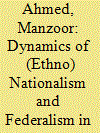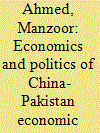|
|
|
Sort Order |
|
|
|
Items / Page
|
|
|
|
|
|
|
| Srl | Item |
| 1 |
ID:
175104


|
|
|
|
|
| Summary/Abstract |
The paper examines how an (ethno)nationalist movement developed and took shape in Balochistan in relation to a broader national question that ranges from seeking provincial autonomy within the federation of Pakistan to gaining independence and formation of a separate state of Balochistan. The paper also analyses the estranged relationship of Balochistan with the state of Pakistan against the background of the failure of the state in accommodating the Baloch national aspirations for economic, social and political rights, while adhering to the basic tenets of federalism. The Baloch, who sporadically engaged in armed conflicts with the state after the British left the Indian Subcontinent in 1947, were not merely the pawns of geopolitics. The conflict in Balochistan must also be seen in a greater context of nationalism as an effort of the Baloch elite to achieve more autonomy within the federal structure of Pakistan. The movement for more national autonomy under the slogan of nationalism may be understood as a tool to further consolidate the social, economic and political strengths of the traditional tribal structure of Balochistan, instead of a struggle for economic and political empowerment of the people of Balochistan. The genuine economic and political aspirations of the people were doubly constrained. On the one hand, the centuries old tribal-centric social structure impeded any social and political evolution in the province and, on the other hand, the limitations of the federal structure in Pakistan restrained Balochistan’s integration into the mainstream national polity and economy. The paper argues that the emergence of nationalism is shaped, firstly by the historical legacy of the colonial era, the identity politics of Baloch nationalists, resource-grabbing and hegemonic approach of the Baloch Sardars or tribal chieftains, and secondly by Pakistan’s failure in adhering to the principles of federalism. Extreme centralization or quasi federalism with its authoritarian nature has promoted regionalism and centrifugal tendencies. Balochistan being a periphery happened to be a fertile ground for the emergence and development of a nationalist movement against the attitudes of the state of Pakistan, which led towards a conflict situation between Balochistan and the state of Pakistan.
|
|
|
|
|
|
|
|
|
|
|
|
|
|
|
|
| 2 |
ID:
169612


|
|
|
|
|
| Summary/Abstract |
As part of the enormous new Silk Route project or the One Belt One Road initiative, the governments of Pakistan and China developed a proposal in the mid-2000s to create an economic corridor from Kashgar, Xinjiang, in China to Gwadar, Balochistan, in Pakistan with an aim to promote national, bilateral, and international economic integration. Essentially driven to improve regional and global trade networks, the resulting China-Pakistan Economic Corridor (CPEC) was formally launched in 2013 with the initially planned portfolio of infrastructure, energy, and economic projects worth around $64 billion. Amidst an optimism in Pakistan of CPEC having a transformational effect on the economy, there is an extensive public debate in Pakistan about the potential impact of CPEC on the already troubled economic and political relations between and within the provinces of Pakistan. This debate is further intensified by the continued representation of CPEC by the country’s political leadership as an overarching programme of economic cooperation, not just a ‘game-changer’ but a ‘fate-changer’, with the potential to address virtually all key longstanding developmental challenges of the country. The principal components of CPEC are Gwadar deep-sea port, Gwadar-Kashgar road and rail infrastructure—that passes through the width and breadth of Balochistan—and establishment of Special Economic Zones (SEZs). It is, therefore, important to analyse the implications of CPEC-related developments on the politics and economics of Balochistan. The SEZs are aiming to boost industrial growth and spur trade in the country and numerous SEZs are planned for Balochistan. The rationale behind these SEZs in Balochistan and elsewhere is to initiate a process of industrialisation. This paper will present how SEZs can potentially affect the economy of Balochistan. While politically Balochistan has been a troubled province with a long history of the estranged relationship with the federation, a relevant point worth investigating is whether CPEC will be a harbinger of a greater economic change (or otherwise) in the province and improve (or further deteriorate) the already tense political situation of Balochistan. The paper offers a contribution in analysing how CPEC can be instrumental in changing the political and economic landscape of Balochistan and how the economic activity proposed under CPEC within the highly volatile political landscape bring any meaningful change to the province.
|
|
|
|
|
|
|
|
|
|
|
|
|
|
|
|
| 3 |
ID:
190746


|
|
|
|
|
| Summary/Abstract |
The article critically examines the presence of political and bureaucratic capture in public sector resource allocation in the province of Balochistan, Pakistan. The article applies robust empirical techniques to evaluate how the political and bureaucratic elite indiscriminately and disproportionally allocate public sector funds to meet two overarching ends: (a) to allow maximum misappropriation of public funds for their benefits and (b) to make constituency/district-specific allocations to buy political allegiance and promote pork barrel and patronage politics (political clientelism). For the empirical purpose, the article uses an unbalanced panel technique using data for districts from provincial-level sources. The empirical results show a strong capture and clientelism in the process of budget making and the allocations of resources/projects to districts/constituencies for incumbent politicians and senior career officials who are at the helm of affairs, making disproportionate budgetary allocations of public resources to their home districts or constituencies or the projects with much leverage of extraction (read bribes) in the process of project allocations, bidding and execution. The evidence suggests that districts, which are neither represented by the incumbency of provincial government nor by senior bureaucrats in ministries that make public policy, receive far lesser budgetary allocations than their proportionate share despite the prevailing poor social and economic landscape. Such capture suffices personal interests, supports clientelism in resource sharing and creates an inter-regional and inter-district/constituency disparity in terms of economic and social development within the province.
|
|
|
|
|
|
|
|
|
|
|
|
|
|
|
|
|
|
|
|
|